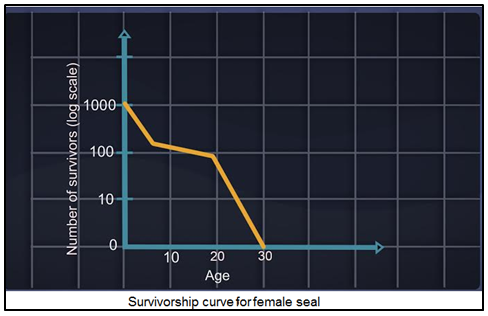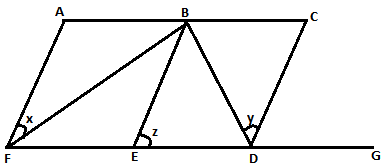7th Grade > Mathematics
PRACTICAL GEOMETRY MCQs
:
Construction: 1 Mark
Steps: 3 Marks
1) Draw a line segment QR of length 8 cm
2) At Q, Draw QX making 45∘ with QR.(The point P must be somewhere on this line)
3) The distance QP has been given. So cut an arc of 5 cm taking Q as a centre.
4) Join the points P and R, you will get triangle PQR.
:
Each part: 2 Marks
(a) Steps of construction:
Step 1: Assume base of the triangle AB = 5.2 cm.
Step 2: Draw a perpendicular on AB at point A, Extend the ray AP.
Step 3: From point B, take an arc of radius 7.6 cm, taking B as a center.
Step 4: The point where the arc and ray intersect is point C.
(b) Steps of construction:
Step 1: Draw line segment BC = 7 cm.
Step 2: Draw an arc with B as the centre and the radius equal to 6 cm.
Step 3: Draw an arc with C as the centre and the radius equal to 9 cm.
Step 4: Name the point of intersection of these two arcs as A.
Step 5: Join points A and B, and points A and C.
Triangle ABC is the required triangle.

The triangle is not a right-angled triangle. It can be checked by a protractor and also by using Pythagoras Theorem. The sides do not satisfy the theorem.
(a) Draw a line l. Draw a perpendicular on l at any point. On this perpendicular, choose a point X, 4 cm away from l. Through X, draw a line m parallel to l.
(b) Line l and m are parallel to each other. A transversal intersects them at points A and B.
i) An arc of suitable measure is taken from B cutting ‘l’ at D and transversal at M (as shown in the figure).
ii) Now, with the same radius and A as the centre an arc FG is drawn (as shown in the figure).
What is the relation between the length of arc DM and arc FG?
[4 MARKS]
:
Each part: 2 Marks
(a) To construct: A line parallel to given line when the perpendicular line is also given.

Draw a line l and take a point P on it.
At point P, draw a perpendicular line n.
Take PX = 4 cm on line n.
At point X, again draw the line m.
(b) Since both the angles are alternate interior angles, they will be equal to each other. Also, since both arcs are drawn with the same radius, they are part of two equal circles. This means that they both have same shape and size. Thus, the two arcs DM and FG are congruent which makes their lengths equal.
:
Construction: 2 Marks
Steps: 2 Marks

To construct: A line parallel to given line by using ruler and compass.
Steps of construction:
1) Draw a line segment AB and take a point C outside AB.
2) Take any point D on AB and join C to D.
3) With D as the centre and taking convenient radius, draw an arc cutting AB at E and CD at F.
4) With C as the centre and same radius as in step 3, draw an arc GH cutting CD at I.
5) With the same arc EF, draw the equal arc cutting GH at J.
6) Join JC to draw a line l.
:
Each part: 2 Marks
(a) Adding up the sides by taking two at a time, we get:
5 cm + 5 cm = 10 cm < 80 cm
80 cm + 5 cm = 85 cm > 5 cm
So we see that the sum of one pair of sides when added is not greater than the third side.
Therefore, we cannot draw a triangle with these measurements.
(b) Adding up the sides by taking two at a time, we get
13 cm + 6 cm = 19 cm > 7 cm
13 cm + 7 cm = 20 cm > 6 cm
6 cm + 7 cm = 13 cm = 13 cm
So in each case, the sum of two sides is equal to the third side.
Hence, this triangle cannot be constructed.
:
B and C
If the distance between any two lines is always constant then the lines may or may not be parallel. If the lines lie in the same plane, then they are parallel and if they are not, they are not parallel.
Pavan tried to draw a line parallel to a given line, 'l'. Few steps are shown below. What will be the next step?
Step 1: Mark a point A, not on the line 'l'.
Step 2: Mark point B on line 'l'.
Step 3: Draw line segment joining points A and B.
Step 4: Draw an arc with B as the centre, such that it intersects line 'l' at D and AB at E.
:
A
Following are the steps to draw a line parallel to a given line:
Step 1: Mark a point A, not on the line 'l'.
Step 2: Mark point B on line 'l'.
Step 3: Draw line segment joining points A and B.
Step 4: Draw an arc with B as the centre, such that it intersects line 'l' at D and AB at E.
Step 5: Draw another arc with the same radius and A as the centre, such that it intersects AB at F.
Step 6: Draw another arc with F as the centre and distance DE as the radius.
Step 7: Mark the point of intersections of this arc and the previous arc as G.
Step 8: Draw line 'm' passing through points A and G.
Line 'm' is the required parallel line.
:
A
When two lines intersect each other, four angles are formed. The pair of angles which lie on the opposite sides of the point of intersection are called vertically opposite angle. If two parallel lines are cut by a transversal:
(i) Alternate interior angles are equal i.e., ∠2 = ∠8 and ∠3 = ∠5.
(ii) Alternate exterior angles are equal i.e., ∠1 = ∠7 and ∠4 = ∠6.
(iii) Corresponding angles are equal i.e., ∠1 = ∠5, ∠4 = ∠8, ∠2 = ∠6 and ∠3 = ∠7.
(iv) Co-interior angles are supplementary i.e., ∠2 + ∠5 = 180∘ and ∠3 + ∠8 =180∘
∠1 = ∠8 is incorrect.
:
As stated in question line segment BD is angle bisector so, ABD=DBC.
So, ∠ABC=4∠ABE




















